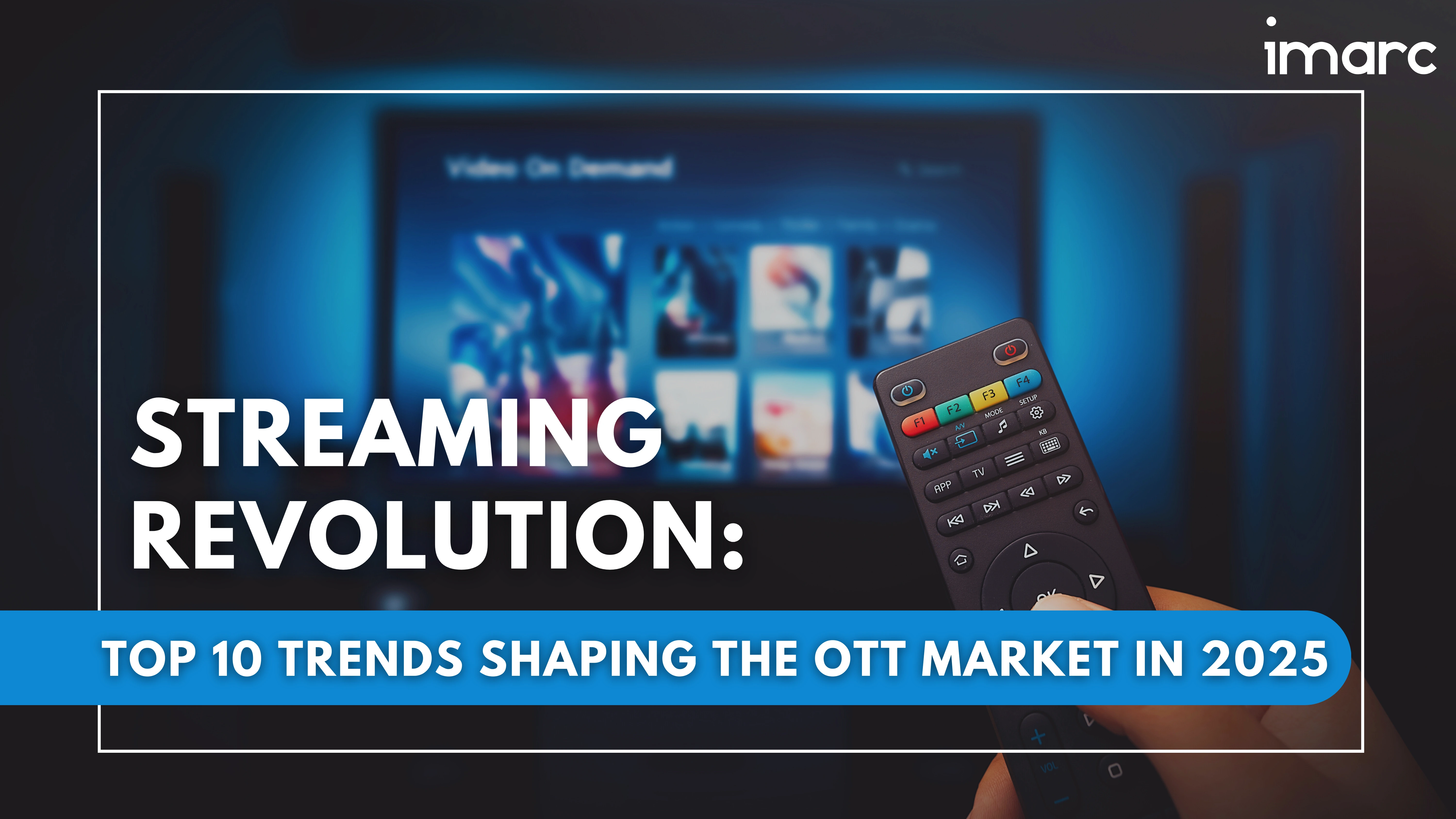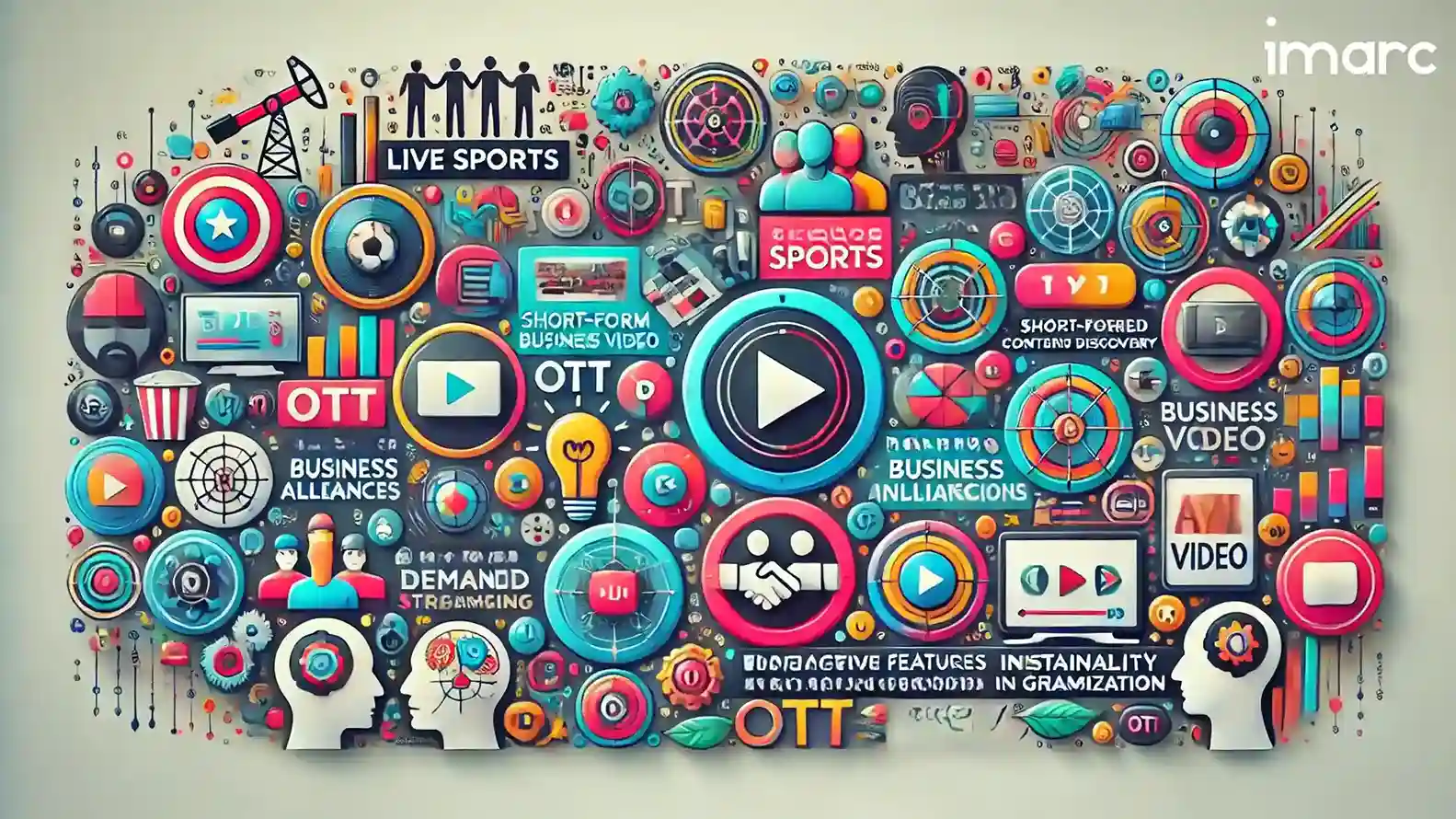Streaming Revolution: Top 10 Trends Shaping the OTT Market in 2025

The OTT industry is experiencing a pivotal transformation, signaling the advent of a new digital entertainment era. Consumers are increasingly demanding convenience and personalized experiences on OTT platforms. As a result, platforms are investing massively in technologies such as AI to enhance the recommendations of content and improve user experience. In addition, with the popularization of 4K and 8K resolutions, the streaming quality is likely to shoot to new heights, ensuring a sharp and immersive viewing experience for consumers. In addition, cloud-based streaming solutions enable companies to scale up efficiently while providing more interactive features such as live events, gamification, and personalized storytelling. The future promises even more engaging, accessible, and customized content for viewers worldwide as streaming services continue to evolve.
The Current Landscape of the OTT Industry:
As per IMARC projections, the global OTT market size reached USD 575.8 Billion in 2024 and is estimated to reach USD 3,741.9 Billion by 2033, exhibiting a growth rate (CAGR) of 22.9% from 2025-2033. The market is driven by technological developments, changes in consumer preferences, and strategic shifts in industries. Widespread access to streaming platforms has been made possible due to the proliferation of high-speed internet and low-priced smart devices. Besides, several industry verticals, such as government, telecom, information technology (IT), banking, servicing, financing, and insurance (BSFI), are leveraging OTT services for advertising. This, in turn, is creating a positive market outlook.
OTT Trends to Watch in 2025:

1. Live Sports:
The convergence of live sports into OTT spaces is set to be one of the biggest building blocks for future growth in 2025. Streaming titans such as Netflix and Amazon Prime Video, as well as Disney+, are now including the sports feature in their vast array of offerings to rope in fresh clientele. For instance, in January 2024, Netflix announced a long-term strategic partnership with WWE to bring Raw, WWE’s flagship weekly program, to the Netflix platform. For the first time in its 31-year history, Raw implemented a huge programming shift, leaving linear television. Starting January 2025, Raw will completely rely on Netflix for audiences residing in the U.S., Canada, the United Kingdom, and Latin America, along with many other regions, which will be added progressively. In addition, real-time engagement is possible through streaming live sports. This is an opportunistic area for OTT platforms that need diversification to reach subdivided groups of their fan base.
2. Short-form Video:
Consumers continue to prefer short-form content, driven primarily by YouTube Shorts, TikTok, and Instagram Reels. Short-form video features will be integrated more deeply among OTT players in 2025 to target younger audiences who tend to prefer quicker, engaging content on mobile devices. These bite-sized videos are increasingly being used strategically for content marketing and audience retention, not only because they align well with shifting viewing habits but also because the attention spans of most viewers are limited. Discovery Plus Shorts on Discovery Plus and Fast Laughs on Netflix are some of the latest short-form video services offered by popular OTT platforms.
3. Strategic Business Alliances:
Leading OTT companies can rapidly augment their content libraries, enhance their technological capabilities, and increase market access by acquiring new platforms or collaborating with content creators, tech providers, and distribution channels. Such collaborations allow for rapid adaptation to the changing viewer preferences and technological developments. Acquisitions can bring in-house advanced streaming technologies or exclusive content, distinguishing a platform from its competitors. Collaborations with local content producers or telecom companies may help access new geographical markets through established local infrastructure or user bases. This strategy helps drive growth and innovation for a company with an enhanced market presence, making strategic acquisitions and partnerships essential to succeed in the dynamically changing OTT landscape. For instance, in November 2024, Reliance Industries announced the completion of the merger of its media assets with Walt Disney’s India business. This deal was aimed at creating one of India’s largest media and entertainment joint ventures worth INR 70,000 crore.
4. AI-Powered Content Creation and Discovery:
By 2025, AI integration in content creation and discovery will revolutionize the OTT landscape. Hyper-personalized recommendations based on advanced algorithms are now being developed to analyze viewer preferences, moods, and watch history in real-time with AI tools. Beyond just recommendations, AI has also begun playing a role in content generation, from scriptwriting to editing trailers, helping platforms produce targeted content efficiently. These tools also enable smarter subtitling, dubbing, and real-time language translation, expanding global accessibility. AI-powered features ensure that platforms remain competitive while viewers enjoy an intuitive, immersive, and tailored streaming experience. This trend shows the increasing reliance on AI to innovate and enhance user satisfaction in the dynamic OTT market.
5. Technological Innovations:
Advancements such as personalization through AI-driven processes, 4K and 8K streaming, and the use of cloud-based solutions are raising the bar for enhanced user experience. For instance, in July 2024, Intel and Olympic Broadcasting Services collaborated to broadcast live 8K at the Paris 2024 Olympics using state-of-the-art H.266/VVC encoding to set a new standard for high-quality and low-latency OTT broadcasts. Other innovations, including Amazon’s Rekognition cloud-based service for providing advanced video and audio analysis with the help of machine learning, are reinforcing the industry dynamics.
6. Increasing Demand from Baby Boomers:
OTT platforms are experiencing a growing wave of interest from Baby Boomers. Baby Boomers, who are between 59 and 77 years of age, are embracing streaming services more than ever. The ease of technology, nostalgia-driven content, and easy access to premium shows and movies are pushing them towards embracing streaming services. Platforms are investing more in classic television series, educational documentaries, and health-focused content to align with the preferences of this demographic. Furthermore, the group values a convenient interface and larger on-screen text, which the OTT providers are increasingly implementing for accessibility. The shift reflects a rising digital literacy from this group, as it has widely adopted smartphones, tablets, and smart TVs in the pandemic to maintain social distancing while staying connected and entertained.
7. Video Monetization:
In 2025, video monetization will be a key trend in the OTT industry, with diversified revenue strategies adopted by platforms to address varied audience preferences and market demands. Hybrid models combining subscription-based (SVOD), ad-supported (AVOD), and transactional (TVOD) options are becoming increasingly popular. The ad-supported tiers, with which companies like Netflix and Disney+ have offered budget-conscious options, appeal to viewers while using AI-powered tools to deliver personalized and less interruptive ads. FAST services such as Tubi and Pluto TV, appeal to the need for consumers for low-cost alternatives to paying for a subscription. Meanwhile, greater flexibility in pay-per-view (PPV) models and microtransactions for premium or exclusive content allow greater flexibility, especially if it is a live event or niche audience. These approaches not only enhance revenue streams but also ensure a broader appeal across varied demographic groups.
8. Telecom Operators Bundling in OTT:
There is an uptrend in the variety of subscription models and the strategic bundling of services, as shown by the introduction of new OTT subscription bundled plans by Vodafone Idea in June 2024. The plans offer varying prices for postpaid and prepaid users, providing them with the ability to watch live sports on services such as Disney+ Hotstar and Sony LIV. Vodafone Idea aims to reach a wider audience, especially sports fans looking for convenient and value-enhanced packages, by combining OTT services with traditional telecom services like data and call benefits. This method improves user loyalty by increasing the perceived value of their subscriptions and also draws a variety of viewers by focusing on specific interests including cricket and football. This approach capitalizes on the connections between using mobile data and utilizing content, increasing the number of subscribers and their involvement in the OTT sector.
9. Sustainability in Streaming:
Sustainability is emerging as an important focus for the OTT industry as concerns for the environment grow and consumers are increasingly looking to be aligned with eco-friendly brands. Streaming platforms are taking measures to minimize their carbon footprint through data center optimization with energy-efficient cooling systems, use of renewable energy sources, and avoiding unnecessary data transfers. For instance, major players like Netflix and Amazon Prime are now keen on reducing the energy intensity of streaming by embracing newer advanced video compression technologies like H.266/VVC, which promises high-quality video at much lower bitrates. Also, cloud-based streaming solutions provide scalable infrastructure that reduces the physical and environmental footprint as opposed to traditional on-premises data centers. As sustainability becomes a competitive differentiator, OTT companies also engage in carbon offset programs and green initiatives to be consistent with the global push to reduce emissions and achieve net-zero targets.
10. Interactive Features and Gamification:
Interactive features and gamification are transforming OTT platforms by providing interactive engagement and experiences. Platforms have incorporated features of interactive storytelling where a viewer can control the story or change the plot, as shown in projects such as Netflix's "Bandersnatch." Gamified experiences, including achievements, rewards, and leaderboards, are used to maintain audience interest and induce repeated viewing. These innovations particularly cater to younger audiences who expect something more than just passive viewing. Additionally, live trivia games, polls, and social viewing features are gaining traction to allow communal and participatory experiences. By combining entertainment with engagement, OTT platforms are not only creating memorable user interactions but also leveraging these features to collect insights for more targeted content and advertising strategies, making gamification a significant trend in the future of streaming.
Future Impact and the Road Beyond 2025:
The reliance on AI, immersive technologies such as augmented reality (AR) and virtual reality (VR), and blockchain will change users' experiences and redefine how content is distributed. Using AI-driven content recommendations merged with AR/VR can give more engaging and personalized experiences to viewers, from virtual cinemas to interactive storytelling. With increased competition, the platforms will develop more diversified monetization models, embracing ad-supported tiers, hybrid subscription bundles, and localized content strategies tailored to global markets. Beyond 2025, sustainability will become more mainstream as platforms invest in carbon-neutral operations and renewable energy solutions in line with global environmental goals. This trend is expected to blur the lines between traditional media and streaming, forming a future where OTT platforms stand at the center of cultural, economic, and technological innovation.
Unlocking Business Opportunities in the OTT Market:
IMARC offers a comprehensive range of services to help businesses expand their reach in key regions to capitalize on the fast-evolving OTT market. Our expert analysts can provide valuable insights into the global OTT industry, along with region-specific market trends, consumer preferences, and competitive analysis. Whether you aim to penetrate untapped markets, refine your subscription or ad-based revenue models, or align your strategies with upcoming trends like live sports, gamification, or sustainability, IMARC Group can guide you at every step. From short-term tactical moves to long-term visionary planning, we help businesses unlock their true potential in the dynamic OTT ecosystem. Reach out to us today to harness these opportunities and secure a competitive advantage in this fast-growing sector.
Our Clients
Contact Us
Have a question or need assistance?
Please complete the form with your inquiry or reach out to us at
Phone Number
+91-120-433-0800+1-201-971-6302
+44-753-714-6104










